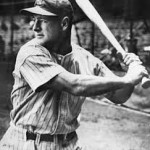If you’re North American you likely know the story, or at least parts of it, even if you’re not a sports fan. Lou Gehrig was not, once upon a time, the name of a disease. He was the Iron Horse, one of the most lethal of the famed “Murderer’s Row” batting lineups of the New York Yankees of the 1920s and
‘30s. One day, an early part of the Gehrig story goes, the Yanks’ first baseman Wally Pipp needed a day off, and a young Gehrig filled in admirably. 2130 games (and 14 seasons) later, he asked to be taken out of the lineup in May of a strangely ineffective ’39 season, and within weeks had had confirmed a diagnosis of amyotrophic lateral sclerosis (ALS), still known to many as “Lou Gehrig’s Disease”. On July 4, 1939, Yankees fans were given their chance to say farewell. By 1941 – on the same date that he replaced Pipp on his way to becoming baseball’s greatest-ever first baseman – he was dead, days before his 38th birthday.
Gehrig was a two-time MVP, six times a World Series champion, a Triple Crown performer, and still

